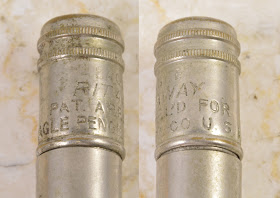This article has been edited and included in The Leadhead's Pencil Blog Volume 5; copies are available print on demand through Amazon here, and I offer an ebook version in pdf format at the Legendary Lead Company here.
If you don't want the book but you enjoy this article, please consider supporting the Blog project here.
The painted wood barrel and smoky gold trim were very familiar to me. Here it is, shown between two Eagle Ritaways:
I wrote about the Ritaway here back in 2012 - it was one of the articles here that had its pictures wiped out by the good folks at Google. In that article I’d noted that while the Ritaway looks to be an evolutionary step in the development of the Eagle Magnum Pointer, the similiarities are in name only. The patent reveals that what’s going on inside is very, very different:
John H. Fischler applied for the patent for the Ritaway on April 19, 1921, and patent number 1,410,666 was granted on March 28, 1922. The top example in that trio of pencils has Fischler’s patent stamped on the cap:
The lower one sugggest that the straight cap examples were earlier, since it has a “Patent Applied For” stamp, dating it to 1921:
The example were are looking at today, though, has something far more interesting stamped on its cap:
“Blaisdell U.S.A. / Patent Applied For.” Without question, this is a pencil made by Eagle for the Blaisdell Paper Pencil Company, a Philadelphia company better known for making paper-wrapped china marker pencils. Blaisdell also made – or had made for it – a s ubstantial variety of wood-cased pencils, too. The company’s offerings in the way of mechanical pencils, though, are very sparse.
And there’s always something about their stuff that suggests Eagle. The brand shows up on page 26 of The Catalogue:
Leadholders like the ones at the top in this picture are marked with the Blaisdell name on the top, and they are usually found sporting an accommodoation clip patented by the Eagle Pencil Company in 1915.
But what I never understood was how Blaisdell and Eagle could have collaborated so much on mechanical pencils when the relationship betweent the two companies wasn’t always so cozy, as this patent infringement case from 1898, brought by Blaisdell against Eagle, suggests:
There’s an explanation. As I was writing American Writing Instrument Trademarks 1870-1953, I ran across and listed several Blaisdell trademarks. One was from 1897, applied for by Thomas B. Homer on behalf of the “Blaisdell Paper Pencil Co.” Then, beginning in the 1920s, there were a proliferation of filings on behalf of “Blaisdell Pencil Co.,” many of which were filed by Alfred C. Berolzheimer, President, or Edwin M. Berolzheimer, Vice President including the one for the Blaisdell name in that distinctive script, filed for registration on December 20, 1919:
The Berolzheimer name stood out like a neon sign to me as I was writing the book, because it was the Berolzheimer family which founded and owned the Eagle Pencil Company (its name was later changed to Berol). Maybe, I wondered, Eagle later acquired its once fierce competitor – and when I followed up on that lead:
In 1938, the Federal Trade Commission filed a complaint alleging price fixing by the pencilmaking industry, naming as defendants “Eagle Pencil Company, New York, and its subsidiary, Blaisdell Pencil Co., Philadelphia.”
I have not found an accurate date when Eagle purchased Blaisdell. My suspicion is that it would have been sometime close to December 20, 1919, when Alfred C. Berolzheimer, identified as the company’s president, filed an application for registration of the Blaisdell trademark (which had been in use, according to the application, since January 1, 1893). It would stand to reason that a new buyer of a company whose value was primarily one of good will and business reputation would promptly take steps to assure that good will was exclusively secured.











No comments:
Post a Comment